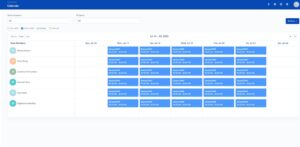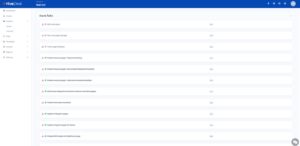Best Practices for Onboarding Remote Employees
5 min read
Onboarding remote employees is a critical part of building a hybrid workforce.
Remote employees are becoming increasingly more common. They are often hired for their knowledge-based skill sets, and most of the time, this presents itself as a knowledge transfer challenge.
It is essential to understand that every remote employee onboarding requires a set of individualized onboarding activities to effectively assimilate themselves into the job, team, and culture.
Considering that many of these employees have no prior exposure to your company’s practices or work environment, the process of onboarding is even more critical to ensure their successful transition into the company.
Table of Contents
What Is Employee Onboarding Process?
Employee onboarding integrates a new employee with a company and its culture and gives the new hire the tools and information needed to become a productive team member.
This process is essential to help new hires get up to speed quickly and feel comfortable in their role. It’s particularly important for remote employees, who may not have in-person contact with other team members or access to the same resources as their on-site counterparts.
The Importance of Effective Onboarding for Remote Employees
- A successful onboarding process should set new hires up with everything they need to succeed in their job, including a comprehensive understanding of company culture and expectations.
The onboarding process will look different depending on whether an employee works in person or remotely. Managers must consider these differences when structuring an onboarding plan for remote workers.
A successful onboarding process will help set the tone for employee success. They’ll be able to hit the ground running in their new role, reducing stress for both the employer and the employee. When done the right way, the onboarding process:
- Help employees become productive quickly to start contributing to your business as soon as possible.
- Helps you retain valued talent by providing a positive first impression of your organization, reducing turnover and the associated costs.
- Offer an exceptional employee experience from day to foster loyalty and create enthusiastic brand ambassadors.
- Make new hires feel welcome and part of the team, even when you’re not in the same office every day.
According to a report by Brandon Hall Group, “Organizations with a strong onboarding process improve new hire retention by 82% and productivity by over 70%.” Plus, 71% of employers believe that onboarding increases employee engagement.
What You Need for Onboarding Remote Employees
Employees hired to work remotely will have different needs than their in-office counterparts. Remote workers are just as valuable to your company and should receive the same high caliber of training and support to ensure they’re set up for success.
Any brand new employee, whether onsite or remote, needs an onboarding program that provides the tools and information they need to get up-to-speed. But the stakes are higher for remote employees since they don’t have access to the same resources that an onsite employee does.
Because of their unique needs, there are specific best practices that you should follow when onboarding new remote employees. These include:
Create a Plan
Onboarding a new employee is a significant investment of time and resources, so be sure to have a clear plan and make sure everyone involved understands what needs to happen and when.
Prepare Your Existing Team
Prepare your existing team for the new employee’s arrival by letting them know what you expect from them and what they can expect from the new hire. Connect them with the new hire before their start date, if possible, so they can begin to build relationships.
Provide Equipment and Materials
Ensure the new hire has all the equipment, materials, accounts, and access they need to do their job effectively. Establishing this kind of normalcy early on helps new hires feel like part of the team.
Use Online Resources for Training
When it comes to training remote employees, plenty of online tools are available that can easily be integrated into your organization’s existing workflow.
For example, video conferencing tools like GoToMeeting or Cisco WebEx allow you to host live presentations on various topics. Employees can ask questions in real-time, and managers can keep an eye on engagement by checking attendance and participation rates at the end of each session.
Communicate Often
Remote employees miss out on many informal interactions that occur in an office setting, so be intentional about keeping them in the loop about everything from office culture to project status updates. Don’t assume that it doesn’t need repeating later because you have communicated something once.
Consider using video conferencing tools like Google Hangouts or Skype during the first week of onboarding to introduce the new hire to their team. This is also a great opportunity for managers to answer any questions or help with any issues that arise during the first few days of work.
Send Welcome Emails and Packages
New employees will appreciate receiving an email or package from their manager or coworkers welcoming them to the company. It’s also a good idea to send a list of resources for remote workers so that new hires know where to find everything they need to do their jobs effectively.
Recognize the Possible Challenges
The following are just a few of the possible challenges of bringing remote employees on board:
- Onboarding processes that assume in-person collaboration and communication (e.g., daily check-ins with your manager or team members, attending in-person meetings)
- Managers who don’t know how to manage remote employees can increase stress for both the employee and the manager.
- A lack of clarity about the goals and expectations for the employee.
- Negative stereotypes about remote workers can cause friction between co-workers (e.g., assuming that remote workers are less productive than in-office workers).
Having the right tools for onboarding is essential to the productivity of your remote workers. A well-prepared remote worker has access to the following:
- A high-speed internet connection
- Robust computer software (anti-virus, password protection, and document sharing)
- Intranet access
- Cloud-based file storage
- Video conferencing capabilities (like Skype, Zoom, or Google Hangouts)
We put together s list of tools for managing remote employees.
How to Prepare for Onboarding
Onboarding remote employees is not the same as onboarding in-office employees. The process requires new challenges, but the benefits of a successful onboarding process can be huge for a remote team. Here are the top five ways to prepare for onboarding remote employees:
Set Up a Dedicated Space in their Home Office
Ensure they have a comfortable chair, monitor stand, and keyboard tray. Outfit them with a laptop or desktop computer with all the hardware they need for their role, including a docking station for their computer. Don’t forget about tech support — your IT team will be busy helping far-flung employees get up and running at home for the first time.
Outfit Them With the Right Tech Tools for Collaboration
Video conferencing tools like Zoom are crucial for regular meetings with supervisors and teammates — and don’t forget about Slack or other messaging tools to keep your team connected throughout the working period.
Plan a Unique Onboarding Experience
Don’t assume that your remote workers need the same onboarding plan as your office-based staff. For example, an office-based worker might benefit from having a buddy assigned to them who can show them the ropes and introduce them to other team members. However, it doesn’t make sense to pair up two people who work remotely! Instead, you should pair them with someone in the office so they can start to build relationships with people they may never meet in person.
Identify Email Addresses and Instant Messaging Handles
Ensure you have all the necessary contact information for your new remote employee well before their first day. It’s easy to overlook this thing when hiring a remote worker. However, the information is essential in easing communication with the new remote employees.
Set Clear Expectations
As you prepare for onboarding remote employees, it’s important to set clear expectations for frequent and effective communication. This is often an overlooked aspect of managing a remote team, but it’s the most critical element of success.
Before you start to onboard remote employees, take some time to think about the long-term potential of your new hire. Do they have any particular skills you have been looking for? Are they looking to advance their career? Are they open to taking on additional projects or learning new skills?
If so, you have the opportunity to set them up with a plan that will help them grow in their role and eventually take on more responsibility. This will help them feel invested in the company and build a stronger relationship with you as their manager.
Follow-Ups Post Onboarding
In the same way that you should have a remote employee onboarding process, it’s equally important to follow up with your new remote hires after the onboarding period.
Conduct weekly check-ins to allow you to address any questions or concerns your employees may have. It’s also a great time to provide them with feedback and discuss what they’ve been working on throughout the week. For example, if they’re working on a big project, this is the perfect time to go over it and make sure everything is on track.
During these follow-ups, review company goals and let the new employees know how their work contributes to your business’ overall objectives. Doing this is another way to boost engagement and productivity.
Conclusion
The best onboarding program can make the difference, ensuring that newcomers are updated on internal company processes and procedures. This can be especially important for remote teams, as it also helps build team cohesion and camaraderie before they meet in person for the first time. Taking the time to prepare a detailed communication plan will help your onboarding efforts immensely.
A time tracking software like HiveDesk can facilitate the onboarding process by automatically logging employee activity, screenshots, and more. Managers can then use this information to provide feedback and ensure that new employees are getting up to speed on company processes and standards.


